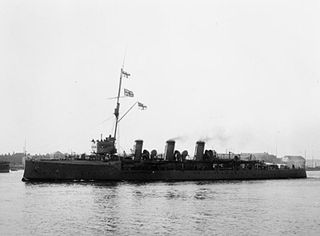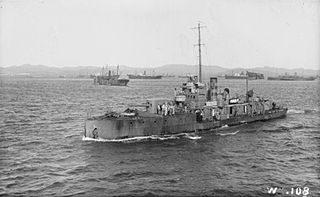
The M29 class comprised five monitors of the Royal Navy, all built and launched during 1915.

HMS Skirmisher was one of two Sentinel-class scout cruisers built for the Royal Navy during the first decade of the 20th century. Completed in 1905 the ship was placed in reserve until she was commissioned in 1907 as part of the Home Fleet. She then spent the next seven years moving on and off of active service in British waters. Skirmisher was assigned to coastal defence duties when the First World War began in 1914, although she was transferred to the Mediterranean in 1915 and then to the Aegean two years later. The ship returned home in mid-1919 and was sold for scrap in 1920.

HMS M30 was a Royal Navy M29-class monitor of the First World War.

HMS M31 was an M29-class monitor of the Royal Navy.
HMS M32 was an M29-class monitor of the Royal Navy.

The M15 class comprised fourteen monitors of the Royal Navy, all built and launched during 1915.
HMS M28 was a First World War Royal Navy M15-class monitor. She was sunk during the Battle of Imbros in 1918.
HMS M27 was a First World War Royal Navy M15-class monitor. She was also served in the British intervention in Russia in 1919, and was scuttled in the Dvina River on 16 September 1919.
HMS M25 was a First World War Royal Navy M15-class monitor. She was also served in the British intervention in Russia in 1919, and was scuttled in the Dvina River on 16 September 1919.
HMS M26 was a First World War Royal Navy M15-class monitor.

HMS M21 was a First World War Royal Navy M15-class monitor. After service in the Mediterranean and the Dover Patrol, she struck a mine off Ostend in January 1918 and sank off Dover.
HMS M20 was a First World War Royal Navy M15-class monitor.
HMS M19 was a First World War Royal Navy M15-class monitor.
HMS M22 was a First World War Royal Navy M15-class monitor. Later converted to a minelayer and renamed HMS Medea, she was wrecked whilst being towed for breaking up on 2 January 1939.
HMS M23 was a First World War Royal Navy M15-class monitor. After service in the Mediterranean and the Dover Patrol, she was also served in the British intervention in Russia in 1919. Converted to the RNVR drillship Claverhouse in 1922, she served in that capacity at "Leith" until 1958.
HMS M24 was a First World War Royal Navy M15-class monitor. After service in the Dover Patrol, she was also served in the British intervention in Russia in 1919. She was sold in mercantile service in 1920.
HMS M18 was a M15-class monitor built for the Royal Navy during the First World War.
HMS M16 was a First World War Royal Navy M15-class monitor.

HMS M15 was a First World War Royal Navy M15-class monitor. She was sunk off Gaza by UC-38 on 11 November 1917.
HMS Colne was a Thornycroft Type River class destroyer ordered by the Royal Navy under the 1903–1904 Naval Estimates. Named after the River Colne in eastern England, north east of London, she was the first ship to carry this name in the Royal Navy.






